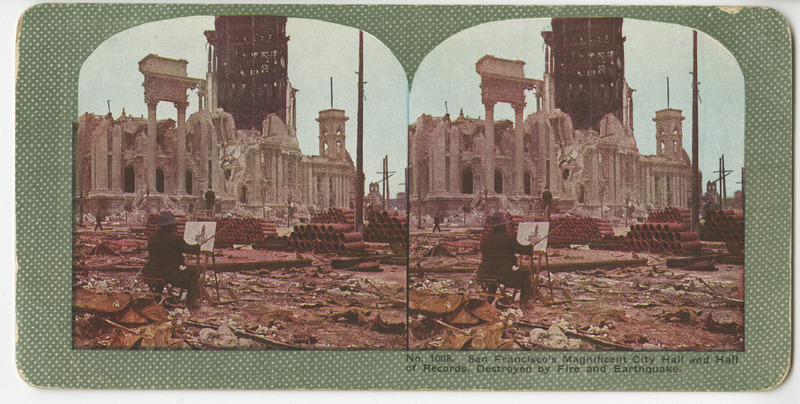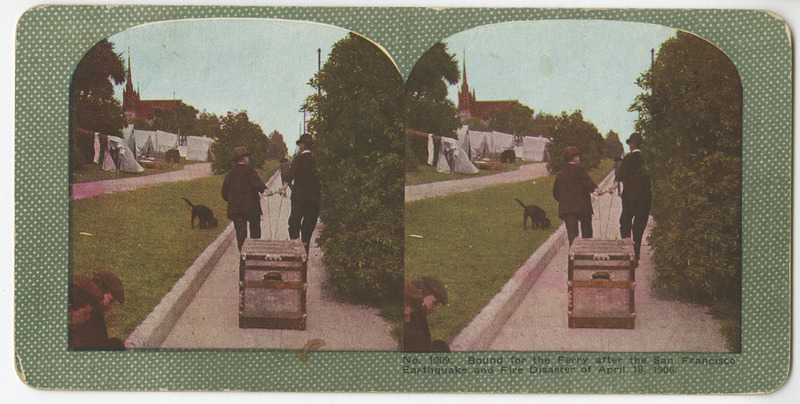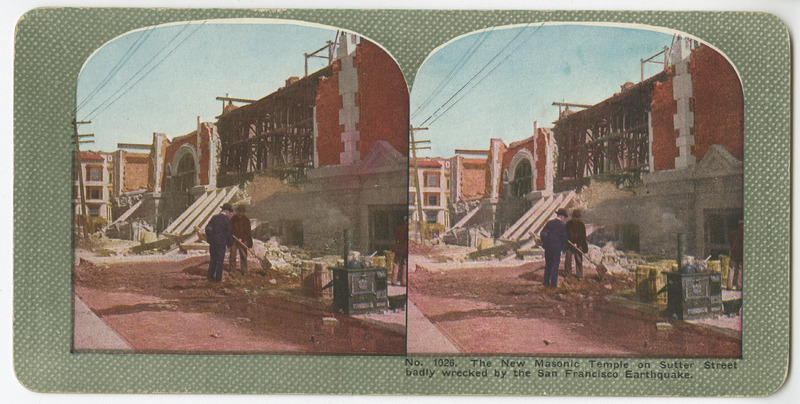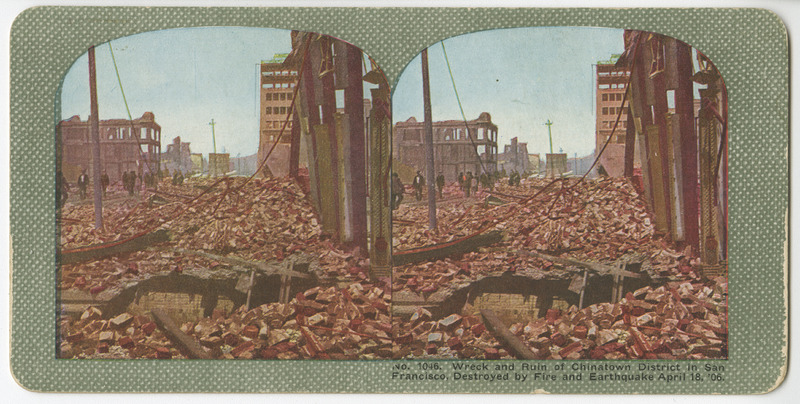The San Francisco Earthquake
In the darkest hours before the dawn, a roaring from deep underground tore through the city like a writhing snake. Buildings breathed, heaved, and tipped. The sound of their groaning timbers and crashing bricks only hidden by the shrill screams of their inhabitants. By the time survivors managed to escape their houses in the hazy morning light, confusion had become horror. Considered one of America’s worst natural disasters, the 1906 earthquake left more than 3,000 dead and destroyed more than 80% of the “most pleasure loving city of this continent.
As one person wrote, “The old San Francisco is dead.”
Below are five stereographs from a collection exploring the earthquake's effect on San Francisco. Each stereograph had a paragraph on the back that created a narrative for the viewer to gain context and learn more about this tragic event.
The most destructive earthquake known in history, before that of san Francisco, occurred at Lisbon, Portugal, on November 1,1755. Three distinct shocks shook the city in such a dreadful manner that every building in the city was completely destroyed. After the first shock many people fled into the churches, believing that there they would certainly be safe, as God would not destroy his own houses; but this faith proved fallacious. At the second tremendous shock all the churches collapsed, burying thousands in their ruins, who were lying on their knees praying. Then the survivors rushed up the hills but many of them never reached the top, where they hoped for safety. The sea had receded from the shore at the first shock, but now returned in a tremendous wall like wave, which dashed up the river Tago, wrecking the shipping, rushing over the embankment and drowning thousands who had assembled on the quays, or were fleeing along the streets of the lower sections of the city. The principal quay, newly built of marble, sank out of sight and hundreds of boats and ships were drawn into the depth and were never seen again.
This is the way Dr. Fleming og Los Angeles tell his experience in a san Francisco hotel during the earthquake.
“I awoke to the groaning of timbers, the grinding, creaking sound, then came the roaring street. Plastering and wall decorations fell. The sensation was as if the building was stretching and writing like a snake. The darkness was intense. Shrieks of women, higher, shriller than that of the creaking timbers, cut the air. I tumbled from the bed and crawled, scrambling toward the door. The twisting and writing appeared to increase. The air was oppressive. I seemed to be saying to myself, will it never, never stop? I wrenched the lock, the door of the room swung back against my shoulder. Just then the building seemed the breath, stagger, and right itself.
But I fled from that building as from a falling wall. I could not believe that it could endure such a shock and still stand.
The next I remember, I was standing in the street laughing at the unholy appearance of half a hundred men clad in pajamas, and less.
The women were in their night robes; they made a better appearance than the men.
The street was a rainbow of colors in the early morning light. There was every stripe and hue of raiment never intended to be seen outside the boudoir.
I looked at a man at my side; he was laughing at me. Then for the first time I became aware that I was in pajamas myself. I turned and fled back to my room.”
The old San Francisco is dead. The gayest, hearted, most pleasure loving city of this continent, and in many ways the most interesting and romantic, is a horde of huddled refugees, living among ruins. But those who have known this particular city by the Golden Gate and have caught its flavor of the Arabian Nights feel that can never be the same. It is though a pretty frivolous woman had passed through a great tragedy. She survives, but she is sobered and different. When it rises out of the ashes it will be a modern city, much like other cities and without its old flavor.
The city is located on a series of hills and lowlands between. These hills are really the end of the coast range of mountains which lie between the interior valleys and the ocean to the south. To its rear is the ocean; but the greater part of the town fronted on two sides of San Francisco Bay. Across the bay to the north lies Mount Tamalpais, about 5,000 feet high, and so close that the ferries from the water front take one in less than half an hour to the little towns of Sausalito and Belvedere, at its foot.
Chief of the foreign quarters was, of course, Chinatown, of which every one has heard who ever heard of San Francisco. A district six blocks long and two blocks wide, when the quarter was full, housed 30,000 Chinese. The dwellings were old business blocks of the earlier days; but the Chinese had added to them, rebuilt them, had run out their own balconies and entrances and had giving it that feeling of huddled irregularity which makes all Chinese built dwellings fall naturally into pictures. Not only this, they had burrowed to a depth equal to three stories under the ground, and through this ran passages in which the Chinese transacted their dark and devious affairs, the smuggling of opium, the traffic in slave girls and the settlement of their difficulties.
There was less of this underground life than formerly, for the Board of Health had a cleanup some time ago; but it was still possible to go from one end of Chinatown to the other through secret underground passages. There were two theaters in the quarter, a number of rich joss houses, three newspapers and a Chinese telephone exchange. No white man, except the very lowest outcasts, lived in the quarter, which was entirely wiped out by the conflagration.
When the burning city seemed doomed and the flames lit the sky farther and father to the west, Admiral McCalla sent a trio of his most trusted men from Mare Island with orders to check the conflagration at any cost of life or property.
With them they brought a ton of one-half of guncotton. The terrific power of the explosion was equal to the manic determination of the fire. Captain McBride was in charge of the squad. Chief Gunner Adamson placed the charges, and the third gunner set them off.
The thunderous detonations to which the terrified city listened all that dreadful Friday night meant the salvation of 300,000 lives. A million dollars worth of property, noble residences and worthless shacks alike were blown to drifting dust, but that destruction broke the fire and sent the raging flames over their own charred path.
The whole east side of Van Ness Avenue, from Golden Gate to Greenwich, was dynamited a block deep, though most of the structures were untouched by sparks or cinders. Not one charge failed. Every pound of guncotton did its work, and through the ruins burned, it was but feebly.




